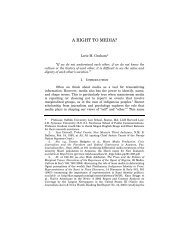The Right to Dignity Rex D. Glensy - Columbia Law School
The Right to Dignity Rex D. Glensy - Columbia Law School
The Right to Dignity Rex D. Glensy - Columbia Law School
You also want an ePaper? Increase the reach of your titles
YUMPU automatically turns print PDFs into web optimized ePapers that Google loves.
2011] <strong>The</strong> <strong>Right</strong> <strong>to</strong> <strong>Dignity</strong> 103<br />
with reason and conscience and should act <strong>to</strong>wards one another in a<br />
spirit of brotherhood”; Article 22 provides that “[e]veryone . . . has the<br />
right <strong>to</strong> social security and is entitled <strong>to</strong> realization . . . of the<br />
economic, social and cultural rights indispensable for his dignity and<br />
the free development of his personality”; and Article 23(3) specifies<br />
that “[e]veryone who works has the right <strong>to</strong> just and favourable<br />
remuneration ensuring for himself and his family an existence<br />
worthy of human dignity.” 180<br />
In combination, the U.N. Charter and the UDHR make a<br />
clear statement about the declara<strong>to</strong>ry significance of establishing the<br />
right <strong>to</strong> dignity as the ultimate value <strong>to</strong> be enshrined in the<br />
foundational documents of a modern society. While it is true that the<br />
con<strong>to</strong>urs of this right are left somewhat undefined (although not as<br />
shapeless as some would have it), the recognition of dignity makes<br />
these documents cohere and provides an internal tuning key <strong>to</strong> which<br />
all the other rights would have <strong>to</strong> be harmonized. 181 <strong>The</strong>se prominent<br />
placements of human dignity within the UDHR are of great<br />
significance. Even though the UDHR carried no binding effect at its<br />
inception, over time, its precepts led <strong>to</strong> a crystallized consensus of<br />
state practice and thus created a binding norm of cus<strong>to</strong>mary<br />
international law. 182 Moreover, the import of dignity within the<br />
UDHR is very broad and advises the creation of both negative rights<br />
based on the right <strong>to</strong> dignity (that would prohibit the state from<br />
violating this right) and positive rights (that would mandate state<br />
enforcement of these rights and also grant a private right of action). 183<br />
Other international and regional agreements reflect these<br />
overarching ideals present in both the U.N. Charter and the UDHR.<br />
<strong>The</strong> International Covenant on Civil and Political <strong>Right</strong>s, the<br />
International Covenant on Economic, Social and Cultural <strong>Right</strong>s, and<br />
the International Convention on the Elimination of All Forms of<br />
Racial Discrimination, all have provisions that hearken back <strong>to</strong> the<br />
180. Id. at 72, 75.<br />
181. See Mary Ann Glendon, Reflections on the UDHR, 82 First Things 23,<br />
24 (1998); see also Hyman, supra note 1, at 13 (noting that “[h]uman dignity is an<br />
abstract concept, but policy decisions are necessarily concrete,” and doubting that<br />
those tasked with “actually us[ing] human dignity as a decision rule” actually<br />
want or have the expertise <strong>to</strong> do so).<br />
182. See Johann van Aggelen, <strong>The</strong> Preamble of the United Nations<br />
Declaration of Human <strong>Right</strong>s, 28 Denv. J. Int’l L. & Pol’y 129, 143 (2000).<br />
183. See, e.g., UDHR, supra note 70, arts. 9–11 (creating negative rights<br />
pertaining <strong>to</strong> the protection against arbitrary arrest) and arts. 22–26 (creating<br />
positive rights, such as the right <strong>to</strong> social security, the right <strong>to</strong> work in safe<br />
conditions, and the right <strong>to</strong> education).















